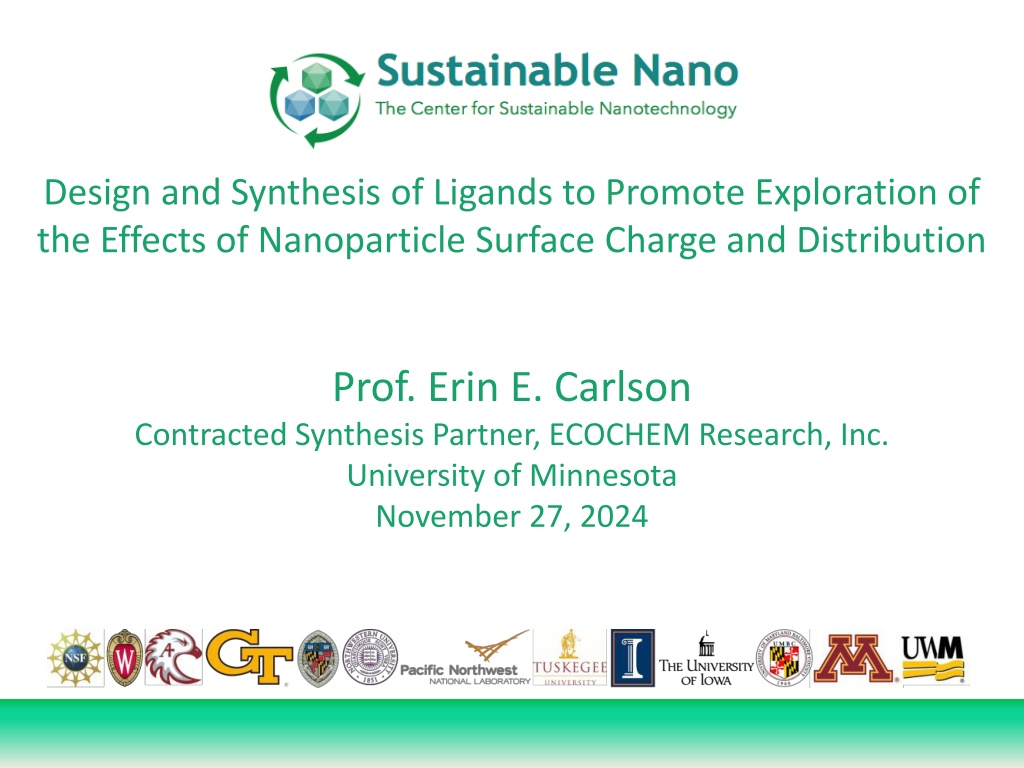Exploring Ligands for Nanoparticle Surface Effects
Design and Synthesis of Ligands for studying Nanoparticle Surface Charge and Distribution, including examples of monomeric and polymeric ligands. Critical design elements of the ligand library are discussed, emphasizing scalable synthesis and key features. Initial synthesis challenges are noted, with improvements achieved through extensive optimization.
Download Presentation

Please find below an Image/Link to download the presentation.
The content on the website is provided AS IS for your information and personal use only. It may not be sold, licensed, or shared on other websites without obtaining consent from the author. Download presentation by click this link. If you encounter any issues during the download, it is possible that the publisher has removed the file from their server.
E N D
Presentation Transcript
Design and Synthesis of Ligands to Promote Exploration of the Effects of Nanoparticle Surface Charge and Distribution Prof. Erin E. Carlson Contracted Synthesis Partner, ECOCHEM Research, Inc. University of Minnesota November 27, 2024
Examples of ligands utilized in previous CSN studies: Monomeric ligands N HS Br (16-mercaptohexadecyl)trimethylammonium bromide (MTAB) N HS Br cetyltrimethylammonium bromide (CTAB) C18 thiol (or any length chain) O O OH O Na O- HS O O Na Na O O 3-mercaptopropionic acid (MPA) trisodium citrate Cl HS NH3 3-aminopropane thiol hydrochloride (MPamine) Previous work has shown that NP surface charge has dramatic affects on their toxicity. We are generating a standardized set of ligands to enable thorough exploration of this issue. 2
Cl NH3 n poly(allylamine hydrochloride) (PAH) O- Examples of ligands utilized in previous CSN studies: Polymeric materials O n poly(acrylic acid) (PAA) n Cl N Cl NH3 poly(diallyldimethylammonium chloride) (PDADMAC) n poly(allylamine hydrochloride) (PAH) n O- O n O S O O Na poly(acrylic acid) (PAA) poly(sodium 4-styrenesulfonate) (PSS) n N Cl Charge density is difficult to control with large polymer-based coatings. (PDADMAC) poly(diallyldimethylammonium chloride) n 3 O S O O Na poly(sodium 4-styrenesulfonate) (PSS)
Critical design elements of the ligand library Modular synthesis that enables generation of ligands with diverse attachment groups and display groups Hydrophobic region near the particle to minimize ligand hydrolysis A similarly sized hydrophilic component that increases water solubility of the resulting NPs Inclusion of only linear connection points (e.g. no amide bonds) to maximize ligand packing Scalable synthesis that does not include prohibitively expensive reagents and reactants or exceptionally low yielding reactions Example Ligand 4
Initial synthesis based on previously reported route Synthesis scheme is dependent on the Williamson synthesis, which is well-known to be low yielding and difficult to reproduce. Initial step in route requires monofunctionalization of the polyethylene glycol which was also irreproducible and low yielding. Iida, et. al Langmuir, 2015, 31, 4054-4062 5
Extensive optimization of the first step in the synthesis scheme improved yield REACTION TRIAL and YIELD Trial #1 No Product (0.0%) NN-61-A Trial #3 1.55 grams (23.6%) NN-63-A Trial #5 1.57 grams (23.9%) NN-71-A Trial #7 & #8 Combined Average 4.12 grams (62.8%) NN-98-A & NN-99-A Trial #2 0.90 grams (13.7%) NN-62-A Trial #4 0.13 grams (2.0%) NN-68-A Trial #6 2.77 grams (42.2%) NN-75-A Optimization included: added potassium iodide, pre-drying PEG, higher temperatures, reaction times of up to 10 days Iida, et. al Langmuir, 2015, 31, 4054-4062 6
Subsequent steps in the literature procedure gave no product Preparation of the tosylated intermediate proceeded normally in >80% yield Critical alcohol reaction produced a complex mixture, even with a simple coupling partner, with minimal (<5%) product This result led to a re-evaluation and re-design of the synthesis scheme Iida, et. al Langmuir, 2015, 31, 4054-4062 7
Synthesis redesign to increase yields, reproducibility and scalability Reaction of bromide-containing starting materials with the desymmetrized PEG dramatically increases yield and ease of synthesis and purification Preparation of the Boc intermediate over four trials gave generally acceptable 0.5-1.0 gram scale yields of 61%, 73%, 59% and 40%, respectively. 8
Synthesis redesign to increase yields, reproducibility and scalability Removal of the Boc to produce the desired pendant amine with TFA appeared to proceed by TLC, NMR and MS. However, product could not be purified by silica or reversed phased chromatography. Additionally, it rapidly oxidizes. Current efforts are focused on development of a PTSA salt crystallization method. This approach may be significantly more complicated when the preparation of the pendant thiol and silyl derivatives is attempted. 9
Re-thinking initial target compounds and synthesis redesign to increase yields, reproducibility and scalability New route was devised to remove previously required desymmetrization step based on the commercial availability of the monobutyl substituted tri-PEG. Butyl-PEG-alkene compound has been produced in good yield. The butyl-PEG-alkene molecule is currently being used for: - Optimization of the alkene to thiol conversion - Functionalization of nanodiamond (Hamers) 10
PRIMARY GOAL: Synthesize gram scale quantities of butyl model compounds for consortium evaluation Or AIBN The multi-gram scale synthesis of the butyl-PEG-alkene demonstrated the potential feasibility of gram scale preparation of the butyl-PEG-thiol and butyl-PEG-silane as illustrated. These compounds will be prepared for distribution as fit-for-purpose models of the alkyl-PEG-alkyl-FG molecular design strategy. 11
Model ligand evaluation goals Evaluation of the butyl series of ligands by the consortium to include: Nanoparticle loading optimization minimal ligand quantity to provide required coverage Nanoparticle loading characterization Ligand fit-for-purpose ; does this ligand design have the characteristics we want? Water suspension, stability, etc. 12
Future directions: Expanding the scope of ligands Purification and stability studies underway Subsequent to the preparation and evaluation of the butyl series of ligands, the next phase of the synthesis program will be to prepare the pendant amine series of alkene, thiol and silane compounds. 13
Acknowledgements Dr. Robert E. Carlson, ECOCHEM Research, Inc. This work was supported by the National Science Foundation Center for Sustainable Nanotechnology, funded as a Center for Chemical Innovation CHE-1503408 [Phase II] Blog: http://sustainable-nano.com























